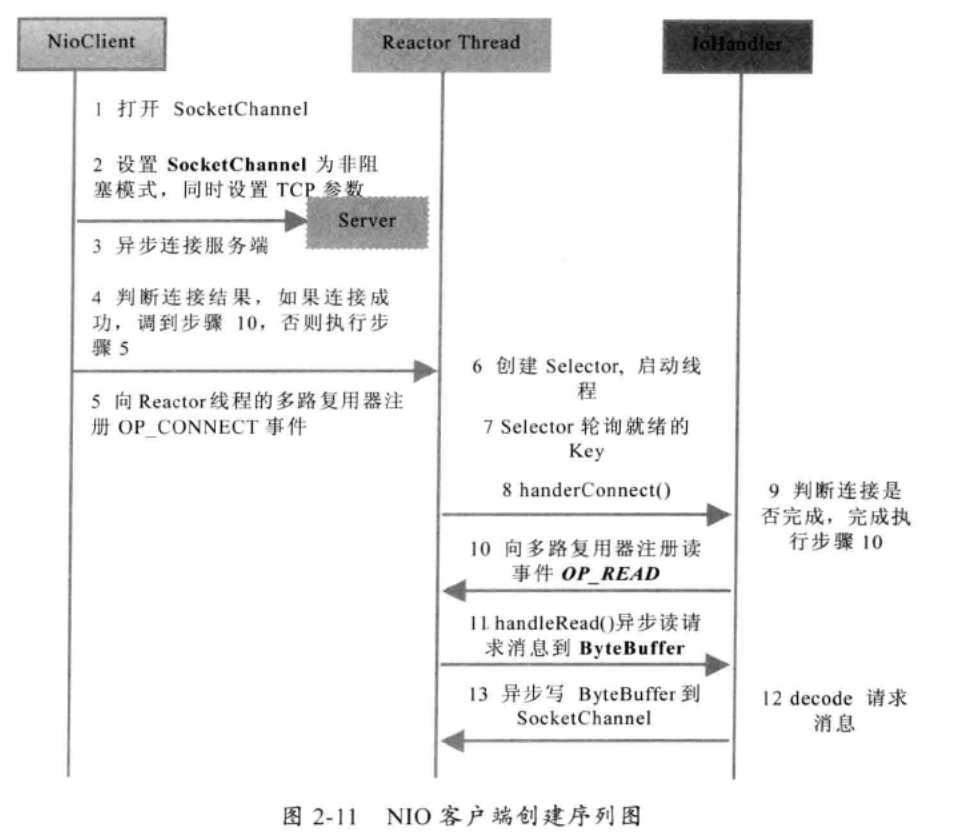Java IO系列之四:NIO通信模型
分布式rpc框架有很多,比如dubbo,netty,还有很多其他的产品。但他们大部分都是基于nio的,
nio是非阻塞的io,那么它的内部机制是怎么实现的呢。
1.由一个专门的线程处理所有IO事件,并负责分发。
2.事件驱动机制,事件到来的时候触发操作,不需要阻塞的监视事件。
3.线程之前通过wait,notify通信,减少线程切换。


NIO使用步骤

服务端步骤:
import java.io.IOException; import java.net.InetAddress; import java.net.InetSocketAddress; import java.net.UnknownHostException; import java.nio.ByteBuffer; import java.nio.channels.SelectionKey; import java.nio.channels.Selector; import java.nio.channels.ServerSocketChannel; import java.nio.channels.SocketChannel; import java.util.Iterator; import java.util.Set; public class NIOServer { public static void main(String[] args) throws IOException { new Thread(new ReactorTask()).start(); } public static class ReactorTask implements Runnable { private Selector selector; public ReactorTask() { try { // 第一步:打开ServerSocketChannel,用于监听客户端的连接,它是所有客户端连接的父管道 ServerSocketChannel acceptorSvr = ServerSocketChannel.open(); // 第二步:绑定监听端口,设置连接为非阻塞模式 acceptorSvr.socket().bind(new InetSocketAddress(InetAddress.getByName("localhost"), 1234)); acceptorSvr.configureBlocking(false); // 第三步:创建Reactor线程,创建多路复用器并启动线程 selector = Selector.open(); // 第四步:将ServerSocketChannel注册到Reactor线程的多路复用器Selector上,监听Accept事件 SelectionKey key = acceptorSvr.register(selector, SelectionKey.OP_ACCEPT); } catch (UnknownHostException e) { e.printStackTrace(); } catch (IOException e) { e.printStackTrace(); } } @Override public void run() { // 第五步:在run方法中无限循环体内轮询准备就绪的Key while (true) { try { selector.select(1000); Set<SelectionKey> selectedKeys = selector.selectedKeys(); Iterator<SelectionKey> it = selectedKeys.iterator(); SelectionKey key = null; while (it.hasNext()) { key = it.next(); it.remove(); try { if (key.isValid()) { // 处理新接入的请求消息 if (key.isAcceptable()) { // 第六步:多路复用器监听到有新的客户端接入,处理新的接入请求,完成TCP三次握手,建立物理链路 ServerSocketChannel ssc = (ServerSocketChannel) key.channel(); SocketChannel sc = ssc.accept(); // 第七步:设置客户端链路为非阻塞模式 sc.configureBlocking(false); sc.socket().setReuseAddress(true); // 第八步:将新接入的客户端连接注册到Reactor线程的多路复用器上,监听读操作,读取客户端发送的网络消息 sc.register(selector, SelectionKey.OP_READ); } if (key.isReadable()) { // 第九步:异步读取客户端请求消息到缓存区 SocketChannel sc = (SocketChannel) key.channel(); ByteBuffer readBuffer = ByteBuffer.allocate(1024); int readBytes = sc.read(readBuffer); // 第十步:对ByteBuffer进行编解码,如果有半包消息指针reset,继续读取后续的报文 if (readBytes > 0) { readBuffer.flip(); byte[] bytes = new byte[readBuffer.remaining()]; readBuffer.get(bytes); String body = new String(bytes, "UTF-8"); System.out.println("The time server receive order : " + body); String currentTime = "QUERY TIME ORDER".equalsIgnoreCase(body) ? new java.util.Date(System.currentTimeMillis()).toString() : "BAD ORDER"; //写应答 byte[] bytes2 = currentTime.getBytes(); ByteBuffer writeBuffer = ByteBuffer.allocate(bytes2.length); writeBuffer.put(bytes2); writeBuffer.flip(); sc.write(writeBuffer); } else if (readBytes < 0) { // 对端链路关闭 key.cancel(); sc.close(); } else ; // 读到0字节,忽略 } } } catch (Exception e) { if (key != null) { key.cancel(); if (key.channel() != null) key.channel().close(); } } } } catch (Throwable t) { t.printStackTrace(); } } } } }
注意:如果发送区TCP缓冲区满,会导致写半包,此时,需要注册监听写操作位,循环写,直到整包消息写入TCP缓冲区
客户端步骤:

客户端:
import java.io.IOException; import java.net.InetSocketAddress; import java.nio.ByteBuffer; import java.nio.channels.SelectionKey; import java.nio.channels.Selector; import java.nio.channels.SocketChannel; import java.util.Iterator; import java.util.Set; public class TimeClientHandle implements Runnable { private String host; private int port;
private Selector selector; private SocketChannel socketChannel; private volatile boolean stop; public TimeClientHandle(String host, int port) { this.host = host == null ? "127.0.0.1" : host; this.port = port; try { //第一步:打开SocketChannel,用于创建客户端连接 socketChannel = SocketChannel.open(); //第二步:设置SocketChannel为非阻塞模式 socketChannel.configureBlocking(false); //第三步:创建多路复用器(在Reactor线程中) selector = Selector.open(); } catch (IOException e) { e.printStackTrace(); System.exit(1); } } @Override public void run() { try { // 第四步:socketChannel发起连接 if (socketChannel.connect(new InetSocketAddress(host, port))) { //第五步:如果直接连接成功,则注册到多路复用器上 socketChannel.register(selector, SelectionKey.OP_READ); //第六步:发送请求消息,读应答 byte[] req = "QUERY TIME ORDER".getBytes(); ByteBuffer writeBuffer = ByteBuffer.allocate(req.length); writeBuffer.put(req); writeBuffer.flip(); socketChannel.write(writeBuffer); if (!writeBuffer.hasRemaining()) System.out.println("Send order 2 server succeed."); } else socketChannel.register(selector, SelectionKey.OP_CONNECT); } catch (IOException e) { e.printStackTrace(); System.exit(1); } while (!stop) { try { //第七步:多路复用器在run的无限循环体内轮询准备就绪的Key selector.select(1000); Set<SelectionKey> selectedKeys = selector.selectedKeys(); Iterator<SelectionKey> it = selectedKeys.iterator(); SelectionKey key = null; while (it.hasNext()) { key = it.next(); it.remove(); try { if (key.isValid()) { //第八步:将连接成功的Channel注册到多路复用器上 // 判断是否连接成功 SocketChannel sc = (SocketChannel) key.channel(); if (key.isConnectable()) { if (sc.finishConnect()) { sc.register(selector, SelectionKey.OP_READ); //发送请求消息,读应答 byte[] req = "QUERY TIME ORDER".getBytes(); ByteBuffer writeBuffer = ByteBuffer.allocate(req.length); writeBuffer.put(req); writeBuffer.flip(); sc.write(writeBuffer); if (!writeBuffer.hasRemaining()) System.out.println("Send order 2 server succeed."); } else System.exit(1);// 连接失败,进程退出 } //监听读操作,读取服务端写回的网络信息 if (key.isReadable()) { //第九步:读取信息到缓冲区 ByteBuffer readBuffer = ByteBuffer.allocate(1024); int readBytes = sc.read(readBuffer); if (readBytes > 0) { readBuffer.flip(); byte[] bytes = new byte[readBuffer.remaining()]; readBuffer.get(bytes); String body = new String(bytes, "UTF-8"); System.out.println("Now is : " + body); this.stop = true; } else if (readBytes < 0) { // 对端链路关闭 key.cancel(); sc.close(); } else ; // 读到0字节,忽略 } } } catch (Exception e) { if (key != null) { key.cancel(); if (key.channel() != null) key.channel().close(); } } } } catch (Exception e) { e.printStackTrace(); System.exit(1); } } // 多路复用器关闭后,所有注册在上面的Channel和Pipe等资源都会被自动去注册并关闭,所以不需要重复释放资源 if (selector != null) try { selector.close(); } catch (IOException e) { e.printStackTrace(); } } } package com.dxz.springsession.nio.demo6; public class TimeClient { /** * @param args */ public static void main(String[] args) { int port = 1234; if (args != null && args.length > 0) { try { port = Integer.valueOf(args[0]); } catch (NumberFormatException e) { // 采用默认值 } } new Thread(new TimeClientHandle("127.0.0.1", port), "TimeClient-001") .start(); } }
抄录地址:


 浙公网安备 33010602011771号
浙公网安备 33010602011771号